September 21st, 2010 · No Comments
It took me quite a while to get around to investigating the parks in London. I think most of this is because I had already been to Hyde Park when I was younger (i.e. less interested in such things) and because I was trying to go to so many museums and city-related destinations that I didn’t really think I had the time. Another unconscious reason, I suppose, is that, while I do love Central Park, I just didn’t really think that parks in the middle of a city would be much to write home about. But I was wrong.
While getting caught up in the crowds and the bustle of the city, I completely forgot to, literally, stop and smell the roses- if you’ll forgive the pun. I know everyone I spoke to on the subject had the same experience, but it truly is amazing to walk a few minutes away from the city and find yourself completely surrounded by green. Kaitlin and I decided to get some take away from Harrod’s and bring it to Hyde Park to eat, and we walked straight out of the city and into the rose gardens. (First we had to pass a horse riding trail. It was amazing!) Once you travel farther into the park, it’s even easier to forget that Harrod’s and Knightsbridge are only a few kilometers away.
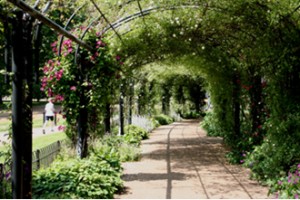
Hyde Park Rose Garden (courtesy of GardenVisit.com)
Hyde Park – photo courtesy of GardenVisit.com
And Regent’s Park, that’s another story entirely. We got off the tube, walked down an upper class residential street, and wound up in what seemed like an entirely different part of the country. With playgrounds, huge green fields, trees, ponds, rose gardens, and high hedges, it is entirely possible to forget that you are in a huge, busy city.
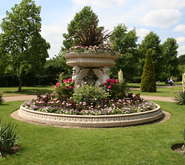
Regent’s Park – photo courtesy of GardenVisit.com
I know it sounds pretty cliché, but it really was fantastic to get back in touch with nature after so seeing much brick and stone day after day. I could have sat and watched the swans swim and stare at the flowers all day. Unfortunately I was only able to spend a few hours in the parks, but it was an amazing diversion from busy city life. And today at Hampstead Heath was completely gorgeous. Some of the girls and I had to take the time to frolic through the fields because we’ve missed nature so much.
Even though I initially dismissed the importance of the parks in London, I loved seeing so much green in the middle of the buildings. And because there aren’t so many skyscrapers in London, it was much easier than expected to forget I was in the city at all. No traffic noise, no pollution, no impatient drivers or pedestrians; just nature, for as far as I could see.
Tags: 2010 Jessica
September 21st, 2010 · No Comments
The parks of London provide a natural respite from the busy, hectic, and stressful atmosphere of the city. Once in them, you are enveloped by a green tranquil, unable to hear the bustle of cars and people outside the parks’ confines. I have personally experienced this phenomenon at several parks, ranging from Regent’s park (where I ran for the first time since surgery! not a bad debut location), Hyde Park, and most others. This type of division between hustle-bustle and repose mirrors the separation of work and play that Fox often talks about.
However, there is also a clear division within the park of activities that mirrors this division of social and work life. There are areas for sitting contemplatively in very silly chairs, which you are supposedly required to pay for. There are areas for looking at quite nice fountains, sculptures, or gardens. Then there are designated areas for sports, with soccer nets and rugby… posts? Tennis courts seem a bit necessary to be fenced off for convenience’s sake. Several little cafés are sprinkled throughout the parks as well.
Regent’s park matches the above description. I’ve made several trips to this park to run, play a bit of ultimate, have a cup of coffee, or just stroll around and look at the great horticulture. However, all of these activities would occur in different locations in the actual park. This segments the activities, and consequently divides the people that enjoy different forms of recreation. Personally, it made me very uneasy. If I were to throw a disc in the wrong area, I risked getting publicly reprimanded (as classmates have experienced). Anyway – it would take quite a bit of time for me to analyze this division (and I really don’t have the experience or expertise to do so) but there has to be some sociological effect. If you have thoughts on this, just comment on this post.
However, not all parks match this model. St. Jame’s park, home of many venereal diseases during the restoration period, per Dennis’ description, is seemingly built for nothing but comfort and relaxing. There are nice little walks along the lake, a couple bridges, some out-of-place fowl, and many large grassy areas upon which you can sit. However, in a couple walks through the park, I never saw anyone playing catch, football, or any other sport in these large areas. Though it was suspiciously absent of proper monuments (at least, I didn’t see many), the website is careful to highlight the pelican feeding from 2:30-3, and the deck-chairs. Weird. More leisure activities. I should note that there is a quite disproportionately small playground for children. However, as a whole, this is not a built-for-fun park. It is a built-for-relaxing-park, and I think is such because of its close proximity to Buckingham Palace. Green Park, also bordering Buckingham Palace, mirrors this model of relaxation, rather than recreational, with a few monuments (such as the Canada memorial), and is a bit more open green spaces rather than pathways-and-lakes. To me, these two parks are just not okay. I envision parks as a place where you can run around, play whatever kind of games you want. Having fancy gardens in parks just seems to counteract this.
Hyde park, the last park I will discuss in this post, blends athletics and relaxation much like Regent’s. And, just like Regent’s, different activities are segmented. There are different areas for sitting in lawn chairs, areas for tennis, I’ve seen people playing soccer on some of the larger fields (quite far away from the chairs, mind you), and the notorious Speaker’s Corner, completely ostracized from any central location. I suspect that its location is completely intentional whatever authority governs the parks wanted to make sure the… colorful characters that frequent the corner would not pollute (in their mind) the rest of the park.
Well, the parks are divided not only from the city but often divided within themselves. What effect this has on the psyche of park attendees, I’m not sure. Though I love the idea of having large parks in cities, I don’t like this division. If you want to have fancy gardens, just don’t call the whole thing a park.

 That these two photos (both personal) came from the same park (Regent’s) makes little sense to me (though the picture from the right, in my opinion, should not even come from a park).
That these two photos (both personal) came from the same park (Regent’s) makes little sense to me (though the picture from the right, in my opinion, should not even come from a park).
Tags: 2010 ChristopherB
September 20th, 2010 · 1 Comment
I used to think that William Wordsworth was kind of a sap, always going on about daisies in a field and all that in his poetry, but since arriving in London, I’ve come to respect his stance a lot more. I still think that Wordsworth is a bit melodramatic, but I understand his need to remember images from nature. I grew up in rural Connecticut, so I’m used to seeing cows, fields, and woods all on my two-minute drive to the center of town. Before this program, I had not spent more than three consecutive days in a city, and I can honestly say that the parks have kept me sane. London is a wonderfully dynamic city, but it’s also exhausting, and I think that the parks here are an absolute necessity for the people who live here.
London, like any major city, is loud, chaotic, fast-paced, and extremely crowded. Walking down Tottenham Court Road is an exercise in agility. Weaving through people all of the time, especially tourists who stop short to take photographs or consult maps, can become extremely frustrating. But inside of the parks, the bustle of the city seems much farther away. In Queen Mary’s Garden at Regent’s Park today, I was almost able to forget that Marylebone Road ran just outside of the gates. It’s quiet, and you can actually hear the sounds of nature. Although some parks undeniably attract more tourists than others, I saw people just laying on the grass sleeping, reading, doing absolutely nothing at all, in all of the parks that I visited. I think that people are just so relieved to be out of the insanity that is London’s streets that they can’t resist the opportunity to sit down and enjoy a quiet moment.
This is reflected in the development of the parks, as well. Regent’s Park and St. James Park were both made into hunting grounds by King Henry VIII, but they’ve become beautiful, public green spaces. Hyde Park and Kensington Gardens really were formed due to necessity; Queen Victoria decided that the public could really use a park to combat the crowded, polluted conditions of a newly industrialized London in the nineteenth century. Wordsworth fell at the beginning of this time–in his day, London was just beginning to become an industrial power, and we can be fairly certain that his description of the city in his poem “Composed Upon Westminster Bridge” were not completely accurate. Wordsworth sought out beauty in nature because he was suffocated by conditions in the city.
Yes, some of the gardens seem a bit contrived (the bridge at St. James Park just happens to offer beautiful, leafy views of both Buckingham Palace and Whitehall), but the English do love gardening. And today in Regent’s Park I saw people ambling slowly through the very well-manicured rose gardens, literally stopping to smell the flowers. Couples were cozied up on benches, people were reading under weeping willow trees, and one gentleman was just conked out in the sun. As I walked down the avenue, I noticed people sunbathing and playing a football match, also a common sight in Hyde Park and Kensington Gardens. No one, regardless of whether or not they were tourists, was in a hurry, and that’s exactly why the parks here in London are so important. People just need an escape from the city for a bit.
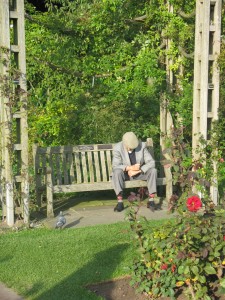
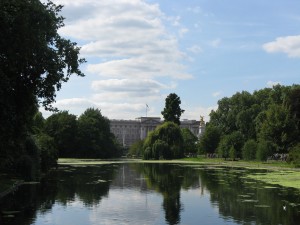
Tags: 2010 Holly
September 20th, 2010 · 1 Comment
Probably because I get a little claustrophobic in cities, my visits to parks have definitely been some of the highlights of my time in London. I enjoyed the sense of space, the people watching, and the sheer beauty of much of the landscaping. However, I did pick up on a certain artificiality throughout London’s Green space.
First of all, the lakes, which are in most cases absolutely beautiful, provide variety in scenery, are home to so many (sometimes exotic looking) species of birds, and they also provide a fun and novel activity for those who choose to rent paddle boats. In St. James Park, the bridge in the middle of the long, central pond is carefully positioned so that visitors can view Buckingham Palace in one direction and the London Eye in the other. The sheer overcrowding of the birds (and their excrement), especially in St. James Park makes me slightly uncomfortable. It seems as though London attempts to make up for the obvious lack of wildlife in the rest of its urban environment by crowding high quantities into small, carefully designated areas. In the “wetlands” area in Regent’s Park, I noticed a rat basking by the water’s edge along side the usual variety of birds. It goes to show I think, that it is impossible to completely keep out the less picturesque aspects of the city.
The gardens that I visited, and especially those in Regents Park were absolutely beautiful. Signs pointed out over twenty different species of roses, and everyone who I saw seemed to walk through slowly. However, when I reflected on how often the grass must be cut, to keep it that short and the precise patterns in which the plants were arranged, the set up seemed more like a human achievement than natural beauty. Hours of work daily clearly go in to maintaining the gardens.
Playgrounds in London’s parks also seemed equally controlled . Every playground that I have seen so far is fenced in, and most do not allow people in unless they have children with them. These playgrounds, which are often large and colorful, must be a welcome refuge to parents who live in the city and are accustomed to having to constantly watch their children in all public places. They definitely reinforce my impression that London makes it a priority to provide leisure space, but only carefully controlled leisure space.
That said, anyone is free to walk into the vast majority of London’s parks. People from all walks of life go there, though it is not a place to interact with strangers. It is socially acceptable to be alone, with large groups of friends or family, or anything in between. In many there is enough space to talk loudly, but I was able to find somewhere quiet in Regents Park to sit and read a book. Maybe all of the control allows for a greater sense of freedom.
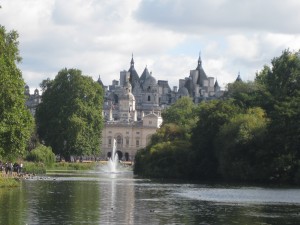
St. James Park (Personal Photo)

Hyde Park (personal photo)
Tags: 2010 Emily · Uncategorized
September 20th, 2010 · 2 Comments
I have been avoiding the parks post because I initially felt like I had very few interesting things to say about them. I’ve spent a ton of time in Hyde Park (because I keep coming back to see if there will be people at Speakers’ Corner), some time in Regents Park and briefly visited the other ones plus the various greens and squares in the middle of the city. A lot of people have already mentioned that the parks are very beautiful, good places to withdraw from city life, make beauty accessible to people of all classes and economic means, etc. All good points, so I won’t beat them to death with another post about them.
I wandered about Hyde Park to a good two hours one day because I got lost, it’s huge, and the landscaping does a really good job of hiding the existence of a city outside the oasis inside (It’s kind of like how the mega Walmart at Dickinson has no windows so once you get in you lose your ties to the outside world and can’t escape, except Hyde Park is absoloutely beautiful and a not soul sucking). Anyway, what struck me as really weird was that a lot of the park seemed to have no other function than to be pretty. Every park I’ve ever been to at home is composed of a playground to entertain kids and open space to play sports. They might be landscaped or otherwise decorated, but that part takes up very little space. Landscaping at home serves as decoration for a space designed for some other purpose, while her prettiness seems to be the main purpose and other functions (open fields, playgrounds, etc.) are an afterthought in a different section. (I’ve also spent very little time in big city park, so it might just be a difference in suburban and urban parks). For example, the first section in Regents Park does not allow balls, so I had to go to a different, less decorative part to play Frisbee. It’s very deliberately divided up.
Assuming it’s not just an urban suburban difference, I think designing a green space just to be a green space and having these deliberate divisions is very in keeping with the English character, the London character in particular. Kate Fox talks a lot about the obsession with privacy. People like to have their own sectioned off garden with a very high fence. They hold up giant newspapers in the subway, stare straight ahead, or make out in very public places as a way to section themselves off into artificial private spheres. The character, Wemmick, from Great Expectations divides his home and work spheres so completely that he seems like he has multiple personality disorder. It’s as if it’s an English disease (thought I think not necessarily always a bad thing).
London is a crowded place, and I can totally understand the need to have all these spheres to create a semblance of privacy. In the Arran House alone, I’ve been having private skype conversations that my entire hallway can hear while sitting in view of one of the cameras at the desk; I’ve just been pretending it’s a private sphere. Parks in London just seems like a strong physical manifestation of these psychological divisions – a section specifically for just being pretty, a section for runners, a section for team sports, a section for free speech (Speaker’s Corner). It’s the very opposite of the complaints I so often here in the United States about our over-stimulated, forever multitasking populace. It actually makes me wonder if British television, advertisement, and video games are significantly different from American ones. As far as I know British students start specializing much earlier, too. In contrast, our education system stresses the idea of the well-rounded student, good at every subject in school and doing a million extracurriculars to get into (among other types of schools) a prestigious liberal art college that continues to focus on well roundedness (required courses in other disciplines), even though the job market is specialized. That’s getting a little off topic, though.
Bottom line: parks — super pretty. Divided into single purpose sections. Reiterate the idea of British spheres for the purpose of privacy (although I think there are many other purposes and results of those spheres besides privacy).
Pictures coming as soon as my computer stops being lame.
Tags: 2010 Jesse
September 20th, 2010 · 1 Comment
London is always described as a global city, a city of history, a city of movement. I have never heard it being described as a city of green space. So I was completely thrown off when I saw the number and magnitude of parks in the city. Literally in every community there is a park whether it’s a well off neighborhood or a less developed neighborhood; it has a park.
In Los Angeles, specifically in the area I live in there are hardly any parks or any parks that you really want to go to. Thus, it was a complete shock seeing such a populated city with so many parks that range in a variety of sizes and functions. The biggest that I have seen by far is Hyde Park. Hyde Park is right next to Buckingham Palace, making its size very logical. Its scenery ranges from fountains surrounded by beautifully well kept flower beds to fields and fields of grass and trees. This park is obviously surrounded by a lot of money to keep up its appearance as well as it is kept.

Around the area we are currently dwelling in, Russell Square is on a significantly smaller scale than Hyde Park but it is likewise surrounded by a well off community. The park is always well kept and sometimes sealed off to the public making access only available to those who live in the square. The park is used by children, yoga instructors, and readers in general. Overall there is a stark difference between life within this park and the surrounding fast pace community. It almost seemed that they have brought the suburb to the city.
Not all parks look as amazing as Hyde Park or Russell Square. In the East End, a community that is largely composed of immigrants from Bangladesh also have a community park, called Altab Ali Park. This park was the first I had seen at the time in London that was commemorating someone rather than being named after its location. Altab Ali was a young 25 year old Bangladeshi clothing worker who was murdered by three white teenage boys on his way home. Just learning about the nature of the name of the park gives you a different feeling about the surrounding community. The community in the East End is tightly knit but it is not necessarily based on their income but rather a form of protection to their neighbors. This park unlike the others is visibly un-kept and run down, a complete difference to those I have mentioned before. So even within British society I see that with money comes political power, sad but true.

Tags: 2010 Jamie
September 20th, 2010 · No Comments
London’s public parks are impressive, in their size, beauty, and sheer number. Most people go to these parks to play sports, have picnics, hang out with their mates (both kinds), sit and read under a tree, etc., but my favorite park activity is people watching; and nowhere in London is the people watching better than in Hyde Park’s Speaker’s Corner. Speaker’s Corner is like an internet chat forum come to life, attracting people from every imaginable social background and point of view. Immaculately dressed women toting around their four figure handbags walk by elderly Sikh men in skull caps with long, gray beards. Middle school aged children in football jerseys weave between bikers and joggers. Indian grandmas in wheelchairs are pushed by their grandkids past punk teenagers in six inch platform boots. London’s parks truly attract all kinds, and Speaker’s Corner is the ideal place to find a varied audience if you have something to say, simply set up your little stool, hop on, and begin your diatribe against the government, the media, the cursed masses, who or whatever. If you have anything even remotely interesting to say, a crowd will soon form around you. Wearing a funny costume doesn’t hurt either, the crazier the better.

Just a guy feeding the pigeons. (personal photo)
I’ve simply strolled through most of the parks here, stopping every now and then to admire a flower or dodge a pile of dog poop, but Hyde Park caught my attention and kept it. Right across from the tail end of the Oxford St. madness you will find the Marble Arch, and beyond it a massive expanse of green space. Speaker’s Corner is lodged conveniently in the middle. The first character I encountered was a militant African man speaking out against the war in Iraq. He looked to be about 25 or so, and around him stood a rather sizable crowd. There was also a group of four physically fit 20 somethings advertising a personal training service and attracting quite a crowd with their boxing gimmick. One of the men held up a pad on each hand and challenged people in the crowd to get in 200 punches in one minute. A group of south asian men egged each other on in friendly competition as the crowd laughed and cheered. I was asked to participate, but declined the request. After I had had my fill of watching overweight middle-aged men try and fail to show off athletic prowess, I moved over to listen to a capital C Crazy preacher and the bemused, laughing, and heckling crowd around him.
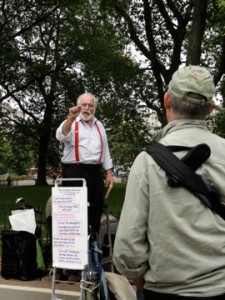
Belligerent preacher pointing at me and asking me something silly like if I knew where I was going when I died. (personal photo)
My favorite speaker was a grizzled old man sartorially channeling the Gorton’s Fisherman. He had a much smaller crowd around him, an interesting mix of homeless people and business men in suits and ties, and me. He wasn’t so much Speaking as having an intimate conversation with his little crowd, discussing poetry and painting, interspersed with personal anecdotes of questionable validity.
Past all of this, Hyde Park is like all the rest, and if you walk in far enough you will undoubtedly be able to stake out your own patch of serenity. Muslin women in full burkas sit and read, couples sit shoulder to shoulder on blankets, its all really a very nice scene. I guess the behavior in the park could be described as English, in that, aside from the liminal space of Speaker’s Corner, people seem to keep themselves, on the whole, its all very orderly.
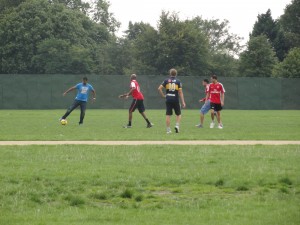
Mates playing a bit of footie. (personal photo)
Tags: 2010 Rachel · Uncategorized
September 20th, 2010 · 2 Comments

One of the things that make London distinct from almost any other city I have visited is the amount or room dedicated to parks. Walk a few blocks and you are bound to encounter a vast expanse of greenery, or see a small garden area with some benches and statues. While a few of these parks (particularly Greenwich) are more organic in nature, and feel just like large open space areas to roam, most of these parks feel planned out to the last blade of grass. Hyde Park boasts a picturesque lake(The Serpentine) with neatly laid out park benches around it. The grass in St. James’ Park is always perfectly cut, and the main bridge in the middle of the park looks like it was installed yesterday. The shrubbery and gardens in Regent’s Park remind one of Versailles. All of these places seem sculpted to be as visually pleasing as possible.

The trend seems to be that the more central the park to the center of the city (Particularly St. James’ and Regent’s Parks), the more likely the park is to be perfectly planned and sculpted. There are several possible reasons for this. One, it could simply be that the city anticipates more people going through these areas, so they want them to look the nicest. Another possibility is that they expect these areas to get the most tourists, and the parks exist more for image than actual recreation (a point I’ll get to a little later). Finally, it could be that these areas are closest to the monarchy, and they have more of a say over these parks. Whatever the reason, there is no doubt that the parks in London are far more mapped out and planned than a majority of parks in American cities.
The question now is: is such planning a good thing? I personally see it as more of a mixed bag. The parks here are much more visually stunning than most I have seen elsewhere. The feel of the parks harkens back to the original intention of the parks: to make the poor and unprivileged feel like they had access to the wealth of the monarchy. You really feel like you are walking through the Queen’s personal gardens when you take a stroll through Regent’s Park. However, this meticulous planning takes away a little bit of personality from the parks. I get no sense of true, organic, nature while walking through St. James because everything feels so mapped out. In addition, the regal nature of the parks appears to hinder a lot of activity within the parks. Most people seem to simply be walking slowly through these areas, or sitting on a park bench. There are rarely any cyclists, joggers, Frisbee players, kids running around, or anyone playing games. This inactivity is partially because a lot of games are banned in certain areas of the parks, but I think it is also due to the intimidating nature of such perfectly sculpted areas. After walking through the immaculately-trimmed hedges of Regent’s, or after crossing the bridge in St. James’ with the marvelous view of Buckingham Palace, it is hard to think: “Gee, this is the perfect place to run around and throw a Frisbee.” As a result of such overplanning, the parks lose this energy, and also a little bit of quirk.

I love the fact that London has so much green space, and that the city takes such good care of these areas. However, the parks are so meticulously sculpted that the areas seem almost unnatural. The lack of physical activity makes the area feel calm, but it also takes something away from its overall personality. I have enjoyed my time walking through London’s parks, but one wonders whether a bit less planning would make these areas more fun and inviting to the public.
Tags: 2010 Andrew
September 19th, 2010 · No Comments
Hailing from a small New England town tucked away in the white mountains of New Hampshire, I’m quite familiar with “green space.” I am actually more unaccustomed to living anywhere even close to a big city. Nearest to home is Boston—a two hour and fifteen minute haul. Therefore, one significant change in living in London is the disappearance of the monstrous mountains, endless trees, and, of course, fresh, crisp air. However, this wondrous city never ceases to surprise me. The parks I have visited are, as many can agree, blessed sanctuaries. I unintentionally have separated the innumerable parks into two groups: the larger, well known ones and the smaller, more secluded ones. Each sort of park provides a different environment.
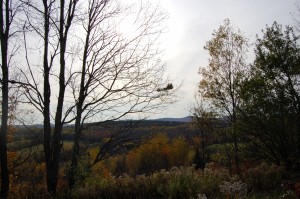
New England’s expansive green space (personal photo)
Of the “royal” parks (they’re labeled as such on London’s website) I have enjoyed Hyde Park and its nearby neighbor, Kensington Gardens; the Green Park, St. James’s Park, and the Reagent’s Park. It is at times entertaining to get lost in these massive parks. As a person wanders, he or she delves deeper into the green refuge and furthers him or herself from the city’s bustle and grime. I enjoyed exploring the incalculable monuments, memorials, and museums that materialize in these sprawling parks. These sanctuaries are not just for people to escape the city chaos; they serve as a safe place to preserve the surrounding area’s detailed history. I researched Hyde Park extensively and the pride the Londoners hold for the history of the park and the area itself is immediately evident. Speaker’s Corner, Rotten Row, Serpentine, the Wellington Museum—they all are housed within Hyde Park to be preserved and honored. For one, Hyde Park Corner Tube Station boasts tunnels decorated with elaborate murals illustrating the area’s history. How that for an introduction?

Hyde Park
The smaller parks have their own benefits. Scattered throughout the city and hidden in unexpected areas of London, these parks also present its community with an opportunity to take a break from the stresses of life. Although, they seem to enact stricter regulations, the parks offer a one with a place for relaxation, tranquility, entertainment, and community. Not to say these features do not apply to the larger parks, but these small parks seem much more intimate and more closely connected to the residents of the area. Also, these parks oftentimes possess a number of historical monuments but to a lesser degree in comparison to the royal parks. Even so, all of these parks in London, regardless of their size, give people a place to take a break from city life or just life in general. And to me, I particularly like that each one prides itself on its distinctive, detailed history.

Bedford Square, the park just down Gower Street
Tags: 2010 Mary
September 19th, 2010 · 1 Comment
I think that one of my favorite things about London is its parks. I have mentioned before in some of my other posts that I don’t think I could ever live in a big city – the crowds and the hurry and the size just stress me out too much. I’ve found that parks are one of the few places where you can have space to walk down a path in a straight line without having to dodge and weave and bump into people and say “sorry.” I’ve found that parks are also a place where you are pretty much guaranteed a place to sit, and you don’t necessarily have to be within ten feet of another person either. It’s lovely that London thought to create places where there is enough space for large amounts of people to be, unlike on the tube or on the streets, where there just simply isn’t. The peace is more beautiful to me than all the trees and flowers and landscaping, although that is pretty too, and a nice break from the architectural chaos of London. I think you really could lose yourself and forget about the city for awhile in parks if you wanted to. When I visited Hyde Park*, I took the following two pictures of the lake:
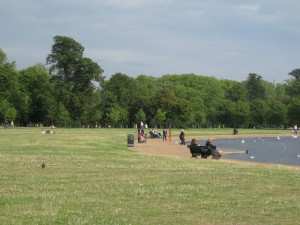
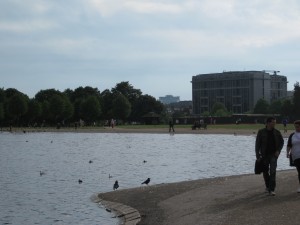
Oh right, the city. There it is. These two pictures seem a bit incongruous; you could probably lie, and tell people that they are different lakes in different places, and they might believe you.
It seems that parks have several different uses for people in London. The first park I visited was St. James Park, and there I joined many other people picnicking on their lunch break. This seems much more enjoyable than inhaling a sandwich on the tube, and if I ever were to work in London, I would want a job where I could eat lunch in the park. The other side of the bridge at St. James however, toward Buckingham Palace, is much more touristy. I was alerted to this by the presence of an ice cream stand, and chairs that you could pay to sit in. I don’t see this as a problem though, as tourists, I am sure, also need a break from the city. Other uses I have seen for parks include
dog walking
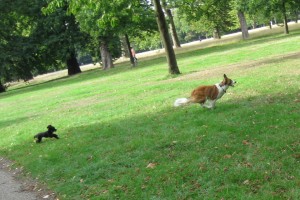
dates

studying

or just being alone and doing whatever you want.

A last really important use for parks, I think, is creating a safe space for children. Professor Qualls brought up this point on the Bloomsbury walking tour, when he took us past the Coram playground, and explained that it was fenced off because you were not allowed in unless you had a child. I saw this again at the Princess Diana Memorial Playground in Hyde Park. It was fenced, plus there was a guard at the door checking people. I witnessed a man come up to the guard and ask if he could see if his wife was in there with his son. The guard told him he could not go in. While this man probably was the father of a child, it is also possible that he could have been a child snatcher, and I personally am a fan of this playground rule that protects children against them. I don’t think we have this in America, or at least I’ve never seen it. At the playground near my house, high school kids smoke pot after school.
While I am excited to move to Norwich and escape the city more or less permanently, when I do return to London, parks will be on my list of places to revisit.
*Note: I am not exactly sure where Kensington Gardens ends and Hyde Park begins. This lake could very well technically be in Kensington Gardens. My apologies to Kensington Gardens if this is the case.
**Note also: all photos in this post are mine. Sorry if you think I’m creepy for taking pictures of random people. It was all in the spirit of academia.
Tags: 2010 Kaitlin


























